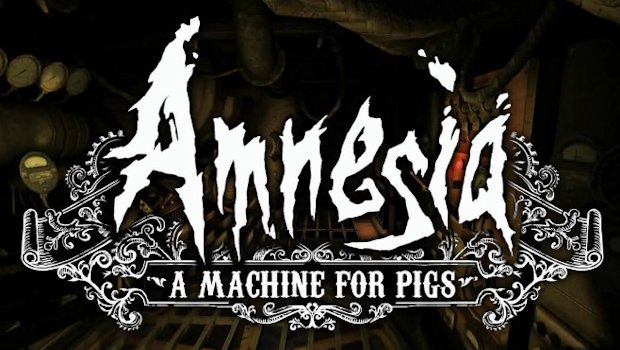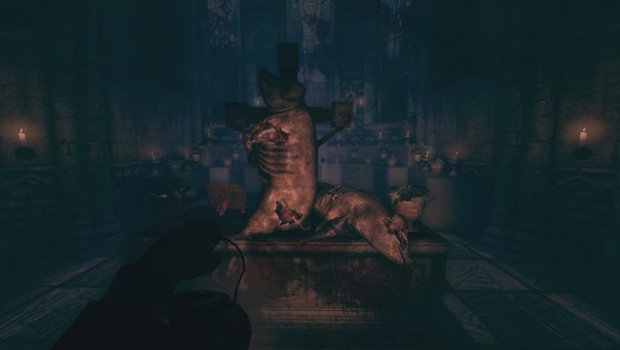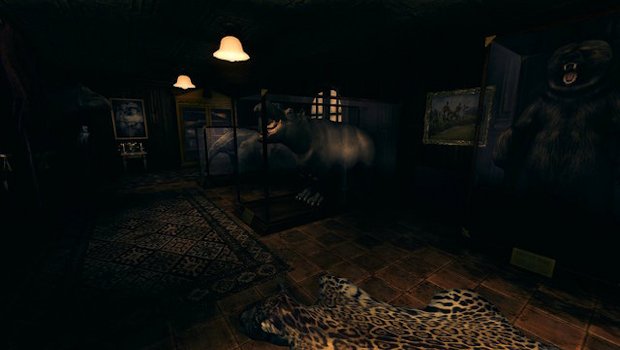Frictional Game’s Amneisa: The Dark Descent is often praised as being one of the best horror games to ever be released. It offered a greatly effective atmosphere that translated into high tension and genuine scares. For many it is the high water mark for horror games during this generation and its indirect sequel, Amnesia: A Machine for Pigs, has been ravenously anticipated by fans.
Developed by The Chinese Room, of Dear Esther fame, Amnesia: A Machine for Pigs puts players in control of Oswald Mandus. Mandus wakes up in his home and immediately sets out chasing after his children, two of whom seem to be leading him to certain end. The house is eerily quiet and empty, seemingly devoid of any life but for the brief flashes of Mandus’s children or something more sinister running away. As a player this put me into an immediate state of unease.
Utilizing some truly phenomenal sound design, the game easily kept me in a nerve wracked state. Every moment that passed brought me closer to what I suspected would be the big scary reveal, and as more and more time went on I genuinely felt uncomfortable playing the game. While attempting to fill up a fuel can, I heard banging from the far side of the garage and then I saw it, briefly. A hulking grotesque figure that sent me into a panic. This is what I signed up for. This is what horror is all about.
Except it wasn’t what it was all about. Shortly after that encounter, where I probably wasn’t even really in any danger, the game lost its hold on me as a device to inflict terror. While I would soon encounter the enemies in the game, enemies that could in fact hurt me, A Machine for Pigs for a variety of reasons became something different. And that wasn’t necessarily the horror game I was expecting.
While not evident at first, A Machine for Pigs varies greatly from its predecessor. Because the game still centers around a protagonist that has no memory of his recent past and at its core is still a horror game, the differences weren’t more clear from the get go. A Machine for Pigs isn’t superficial in its horror. Sure there is a great deal of tension in the beginning, but that tension was manufactured by my own expectations of what this game is. The horror of A Machine for Pigs isn’t one of monsters in the dark but rather the monsters in our hearts.
It was at the point where I realized what the game was trying to say to me that it moved from being a thoroughly effective horror game to being a delivery device for a narrative. Although you can die, A Machine for Pigs is more intent on delivering its story in an experiential fashion, much like Dear Esther. It gives you the resources and direction to progress with little to no danger.
No longer do players have to collect resources to maintain their light source; instead, the lantern never runs out. This makes sense given the setting, 1899 during the industrial revolution, but it eliminates the tension that builds from knowing you only have one tinder box left and just a touch of oil to light your way. And without a reason to conserve my light source, I walked through the game with my lantern out the entire time. Doing this, which I believe is what the designers wanted players to do anyway, presents another problem. Any time any sort of danger is near, the lantern will flicker. This flickering is explained away via a story bit but regardless all it does is take another source of tension and handicap it drastically. This brings us to the final issue: with constant light and a warning trigger alerting players to danger, it became very easy to avoid any and all potential dangerous situations. And with that, the game loses its hold on players as a device for delivering horror because tension can not be effectively manufactured.
Because of this, A Machine for Pigs must rely on its story to pull players through. It mostly does a good job. Like Dear Esther, The Chinese Room has a very clear vision of the message it wants to deliver, which is something that I couldn’t say about the convoluted narrative delivery of Amnesia: The Dark Descent. At a couple points, the game feels like it buys a bit too much into how smart it is at delivering its social commentary, which ultimately undermines some of its effectiveness but not enough that it hurts the overall quality of the game’s narrative.
Amnesia: A Machine for Pigs wasn’t the game I had signed up for but I came to enjoy it despite the differences from its predecessor. Ultimately though, while I appreciated the storytelling method, the game was more interactive narrative than it was game for me. This is something we are seeing more and more often and while it encourages and allows for better storytelling, we seem to be losing the game portion along the way. In many ways it is kind of funny that a game entitled A Machine for Pigs is less mechanical than its predecessor. But, maybe, this just proves that there is place in games for both types of experiences.
Note: This review was written with material received from the publisher. For more on our review process, please read here.


